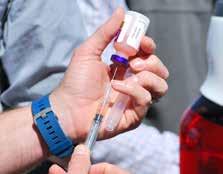
4 minute read
Ask the Nutritionist
How do we provide a balanced diet to a performance horse with a suspected food allergy?
ANNA PESTA, PH.D., EQUINE TECHNICAL SOLUTIONS, PURINA ANIMAL NUTRITION
Advertisement
Ask the Nutritionist is a monthly column featuring questions answered by PhD equine nutritionists and sponsored by Purina Animal Nutrition. Have a nutrition question you want to see featured? Email Marie Rosenthal. For clinics looking for specific nutritional advice, visit purinamills.com/ask-an-expert.
With increasing frequency, equine nutritionists are being asked to review the results of serum allergy tests. It’s not uncommon for results to show dozens of positively reacting allergens. Frustrated clinicians or owners understandably ask, “What on earth can we feed this horse?”
The answer lies at the end of substantial questioning and some trial and error.
EXPLORE ALL THE OPTIONS
First consider the horse’s clinical signs, which should narrow the field of what is truly bothering the horse. Are we dealing with an environmental factor, such as mold or pollen? Is there a skin hypersensitivity to insects or plants? Or, more rarely, is there inflammation or digestive upset due to a true food allergy? Hives, runny eyes, nasal discharge and coughing are more indicative of an inhaled allergen.
To help minimize exposure to respirable dust and molds:
• Trade long-stemmed hay for a complete feed
• Wet hay thoroughly before feeding
• Feed at ground level
• Wet stall bedding or change the type of bedding
• Provide as much pasture time as possible
To help manage horses with skin irritations:
• Change or eliminate topical products
• Use fly sheets and adjust pasture turnout to help reduce exposure to insect bites
• Use appropriate medications during the horse’s “difficult season”
• Supplement feed with a source of omega-3 fatty acids, such as Purina® Amplify® High-Fat Horse Supplement
However, if symptoms are unresolved or unexplained, it is time to pursue an elimination diet.
CONDUCTING AN ELIMINATION DIET
When only one or two feed ingredients are suspected, contact the feed manufacturer for a product recommendation that does not contain the suspect ingredients. However, when there’s a long list of potential allergens it becomes extremely difficult to find a balanced feed free of all the suspect ingredients. In these cases, a true elimination diet is required.
A horse that’s been on a good plane of nutrition can be fed a hay-only diet (choose a type that did not show positive on the serum allergy test) for at least two to four weeks to observe if the symptoms resolve. If there is no improvement in symptoms, a food allergy is unlikely. If symptoms resolve, then ingredients can be reintroduced one at a time until clinical signs reappear, thereby identifying the allergenic feed ingredient to avoid.
DESIGNING THE DIET
In cases with confirmed sensitivities where there are multiple offending ingredients or ingredients that are particularly hard to avoid in commercial feeds, it may be necessary to enlist the help of an equine nutritionist to design a balanced diet. Diets that provide necessary nutrients to maintain body condition and fuel for the performance horse might include alfalfa hay, vitamin/mineral supplements, grain (oats/barley/corn) for energy, oil for added calories, some beet pulp to hold it together and, if a soy-free source of quality amino acids is required, milk replacer powder can be used. Clearly this can become cumbersome for the horse owner to maintain, hence the due diligence to make sure it is truly necessary.
DIAGNOSTIC LIMITATIONS
SERUM ALLERGY TESTING is convenient and, when paired with clinical signs, can be a good starting place. However, it has significant limitations for diagnosing food allergens and is prone to false positives. 1 Intradermal skin testing is the gold standard to diagnose skin hypersensitivities but has limitations in the field. 2 The American College of Veterinary Dermatology states that serum allergy testing and intradermal skin testing are not valid tests for the diagnosis of food allergies and the identification of specific food allergens. The only way to accurately diagnose a food allergy is an elimination diet.
Contact a Purina Ph.D. nutritionist for consultations through Purina Customer Service, 800-227-8941 or send us a message at www.purinamills.com/ask-an-expert.
Upcoming Topics May: Endocrine disorders June: Infections July: Colic
Have a question you want to see featured? Send them to modernequinevet@gmail.com.
1 Dupont, S., A. De Spiegeleer, D. J. X. Liu, L. Lefère, D. A. Van Doorn, Hesta, M. 2014. A commercially available immunoglobulin E-based test for food allergy gives inconsistent results in healthy ponies. Equine Vet. J. DOI: 10.1111/evj.12369 2 Bethlehem, S., Bexley, J., Mueller, R.S. 2012. Patch testing and allergen-specific serum IgE and IgG antibodies in the diagnosis of canine adverse food reactions. Vet. Immunol. Immunopathol. 145, 582-589

ABOUT THE AUTHOR Dr. Anna Pesta, Ph.D., is a nutritionist on the Equine Technical Solutions Team at Purina Animal Nutrition. She is a lifelong equestrian and actively competes her off-the-track Thoroughbred in three-day eventing.



